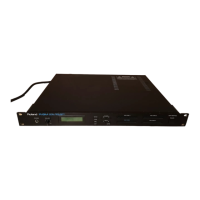Roland
Exclusive Messages
I Data Format
for Exclusive Messages
Roland's MIDI imptemeniaikm us«$
the ftdlowing data [ormai
for all
exclusive
messages (type
IV)
:
Syta DsscrlotrOn
FOH Exclusivs status
41H Msnufacturer ID (Roland)
DEV Oevic« ID
MDL Modsl ID
CMD Command ID
(BODY) Main data
FTH End of axclusiva
3 MIDI status : FOa
F7H
An
exclusive messajie must t>e Hanked by a pair o[ status
codes, siartins
with
a
Manufacturer^lD immediately after FOH
(MIDI
versionl.O).
-
ManufacturerJD : 41
H
The Manufacturer-ID identifies (he manufacturer of a MIDI
instrument
that triggers an exclusive message.
Value
41H
represents Roland's
ManufaciureMD.
= Device-ID: DEV
The Device-ID contains a unique
value that identifles
the
individual device
in the
multiple implementation of MIDI
instruments. It is usually set to OOH
-
OFH.
a value smaller
by one than that of a basic chann^, but
value OOH
-
IFH
may be
used
for
a device with multi^ basic channels
rModellD:
MDL
The
Model-ID contains a value (hat uniquely identifies one
model from another. Different mod^
however, may share an
identical Model-ID if (hey handle similar data.
The Model-ID format may contain OOH in one or more
places
to provide an extended data field. The
following
arc examples
of valid Model-IDs. each representing a unique model
:
OIH
02H
03H
OOH. OIH
OOH, 02H
OOH, OOH. OIH
CMD
The Command-ID indicates the function of an
exclusive
message. The Command-ID format may contain (X)H in one or
more
places to
provide
an extended data Tteld. The
following
are examples of valid Command-l[)s, each representing a unique
function
:
OIH
02H
03H
OOH. OIH
OOH, OZH
OOH, OOH. OIH
r
Main
data : BODY
This
field contains a message to be exchanged across an
interface. The
exact dao siie
and
conten(s will vary with the
ModeMD
and Command-ia
::Command-tD
Address-mapped Data
Transfer
Address mapping is a technique for transferring messages
conforming to (he data format given in Section I. It assigns
a series of
memory-rcsidenl rccords-wavefonn
and (one da(a.
switch status, and parameters, for example-to specific
locations
in a machine<]ependent address space, thereby allowing access
(o data residing at (he address a message
specifies.
Address-mapped data transfer is therefore independent
of
models and da(3 categories. This technique allows
use of
(wo
different (ransfer procedures: oneway transfer
and handshake
transfer.
One-way transfer procedure (See Section 3 for details.)
This procedure
is suited for (he transfer of a
small
amount oi
data.
K sends out an
exclusive
message completely
iodepcndcni
of a
receiving
device s(a(us.
Conn*otlon
Oiasram
Oevics (A) Oovicfl
(6)
MO OUT MO N
-
MO OUT
Connection a( poin( 2
is essential
for
procedures. (See Sec(ion a)
'Rc<]ues( data
"
;
Handshake-transfer procedure (See Section 4 for details.)
'
This
procedure ini(iates a predetermined (ransfer
sequence
(handshaking) across the interface tieforc data translur
(akvs
place. Hartdshaking ensures that reliability and transfer
speed
are
high enough to handle a large amount of data.
ContMotlon Diagram
Oavics (A)
Device
(S)
Connection at
points 1
and
2
is essential
Notes
on the
above two procedures
*There are separate Command-IDs for different (ransfvr
procedures.
*Devieei
A
and
B
cannot
exchange data
unless
they use thf
same
(ransfer procedure, share identical DcvicclD and .Model
ID,
and are ready for communication.
gH
One-way Transfer Procedure]
This
procedure
sends
out da(a all (he way
until ii stops and
is used
when
the messages are so short that ansucrbacks need
not be checked.
For
long messages, however, (he
receiving
device
must acquire
each message in time with (he (ransfer sequence, which
inserts
inten/als of at least 20 milliseconds in
between.
Message
Command iD
Raguest
data
I
Data sat 1
RQl (IIH)
DTI (IZH)
Typ«i of MM*>gM
: Request data 3I
:
RQl (IIH)
This message is sent out
when
(here is
a need to acquire
data
from
a device a( the other end
of the interface. It contains
<iJiii
for the address and size that specify
desicnaiion and
leniidi.
re^ectively, of data required.
On
receiving
an ROl message, the remote device checks
its
memory for the data address and size
(hat satisfy
the request.
if it finds them and is ready for communication,
(he device iviii
[ransmi( a "Data
set 1 (DTD" message,
which contains the
requested
data.
Otherwise,
the
device will
send
out nothing.
Byta Description
FOH Exclusive
status
41H Manufacturar ID (Roland)
DEV Device ID
MDL
Modal
10
IIH
Command ID
aaH
Address MSB
LSB
SiH
Silo
MSB
LSS
sum Check
sum
F7H End of
exclusive
116

